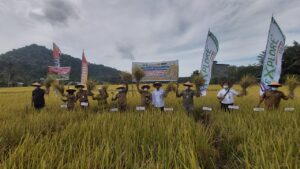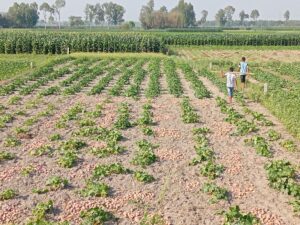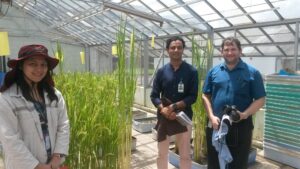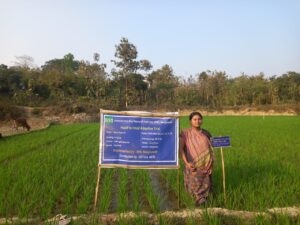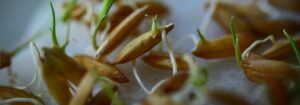
Reporting the impact of an 8-year drought on rice production is a strange caper, I thought, as the wheels of a four-wheel motorbike covered me head to toe with mud. I was sitting behind Rob Houghton, a farmer from just outside Leeton in the Australian state of New South Wales, who was driving me through the pouring rain to his … soybean field. When I met Mr. Houghton, I expected him to take me to his rice field. The problem is, he’s not growing any this year. Despite the morning’s deluge, Mr. Houghton wasn’t allocated enough water this season to ensure a good rice crop. The alternative was soybeans, which, although not as profitable don’t need as much water.
“There have been only 2 years since my father started growing rice here in 1942 that we haven’t grown rice, and they’ve been in the last 5 years—this year and 2 years ago,” says Mr. Houghton.
Australian rice production from 1999 to 2002 averaged more than 1.3 million tons per year. In 7 years, from 2003 to 2009, the average was less than 360,000 tons. The 2008 harvest saw the lowest production since the industry began in Australia, at a mere 19,000 tons. The drought average is actually flattered by a million-ton cropin 2006, partly the result of an advance of growers’ future years’ water. The 2010 crop is expected to bring in around 185,000 tons.
Mr. Houghton farms 520 hectares in the Riverina region of southwest New South Wales, which includes the Murray Valley, Murrumbidgee, and Coleambally Irrigation Areas. Overall, the region is home to around 1,500 rice-farming families.
Before the drought began in 2002, Mr. Houghton grew a rice crop of 100–150 hectares each Australian summer (planting in October-November and harvesting in March-April). His farm yielded about 10 tons per hectare. Since the rains failed, that area for rice has fallen to an average of around 30 hectares per year, excluding the seasons in which he grew no rice at all.
“The summer crop is where we really make our money,” says Mr. Houghton. “In drought times, though,we’ve really ramped up our winter crop program because your water goes so much further.”
The long-term lack of rain has not only reduced the amount of water available to farmers, but it has also increased water requirements when rice is grown. In better times, Mr. Houghton needed 13 million liters (megaliters) of water per hectare per season to grow rice. In the 2008-09 season, with water tables sinking lower and lower after almost a decade of drought, the figure was 22 megaliters.
“We just need a good wet winter to sort that out,” says Mr. Houghton. “It’s only a short-term impact, but you can’t grow rice economically using 22 megaliters per hectare and, environmentally, it’s not a sound move either.”
Water sharing

Aside from limiting crop choices, he says that the dry spell has forced the region’s rice growers to make fundamental changes to the way they farm. Growers are becoming much cannier in the way they shape their fields to make the best possible use of the water they have. By using clever contouring, coupled with well-planned drainage and recirculation systems, many Riverina farmers can grow a winter crop by simply using the residual moisture of the preceding rice crop—no or minimal supplementary irrigation is needed.
Such efficient use of water (Australian rice growers are regarded widely as the most water-efficient in the world) is one of the arguments the rice industry here uses to counter claims by many—especially people living in the parched southern Australian cities—that water-thirsty rice simply shouldn’t be grown in temperate Australia. If you look at rice as part of an annual cropping cycle, the water used per ton of food produced presents a far more compelling equation than that of rice viewed in isolation.
Nevertheless, according to Arlene Buchan, healthy rivers campaigner for the Australian Conservation Foundation (ACF), current levels of water allocation present a major threat to rivers and wetlands in the Murray- Darling Basin. As the country’s food bowl and most important river system, the basin supplies water to the majority of Australia’s population in the cities, towns, and farms across the more densely populated southeast quarter of the continent.
“Overextraction of water for irrigation is the biggest driver of environmental degradation,” says Dr. Buchan, who also points out that the ACF itself is not anti-rice. “The way you fix things is not by mandating what crops you can grow in what areas. You fix it by getting the sharing of water right. If you say to a rice or cotton grower, ‘no more rice, no more cotton,’ they’re just going to grow something else. They’ll use the same amount of water, which doesn’t benefit the environment.”
Rice: last in the hierarchy

Water in the Murray-Darling Basin is allocated in a hierarchy, beginning with “critical needs” (for domestic, industrial, and stock use), followed by so-called high-security entitlements (for permanent plantings such as fruit trees and grapevines), and finishing with general security entitlements (for annual crops such as rice and wheat). In times of water shortage, allocations for annual crops—which can be effectively switched on and off each year—are slashed first. In this way, water availability dictates what farmers can and can’t grow. The implication is that, if allocations are appropriate, the question of banning specific crops—such as rice or cotton—is a moot one.
Coleambally rice grower Lynne Stuckings, who farms 405 hectares with her husband, John, grew around 145 hectares of rice annually before 2003. “Since the drought, we’ve had a couple of years without rice,” she laments. “Last year, we grew 24 hectares; this year, we’ve got 48 hectares.”
Ms. Stuckings contends that many growers feel that there is sufficient water allocated to the environment already, though she concedes that it’s a farmer’s point ofview. Regardless, she says, “We look after our environment—we want to pass our farm on to future generations. We’re not actually wasting water; we’re growing food with it.”
Wayne Meyer, professor of natural resources science at the University of Adelaide, spent almost 2 decades working on irrigation issues in the Riverina region with the Commonwealth Scientific Industrial and Research Organisation (CSIRO) and Charles Sturt University. He agrees with the ACF that there needs to be a rebalancing of water allocations.
“The evidence is absolutely stark that the water entitlements have been over allocated,” he says.
When the allocation system was set up, there was less environmental awareness, in general, and the government awarded licenses in numbers “which far exceeded in dry times any capacity for the system to deliver,” says Prof. Meyer. “The consequence is that the river is drying from the mouth up. Having it dry up before it gets to the end is a sure way to stuff up your natural resources.”
However, Prof. Meyer also agrees that blaming rice farmers is not the solution. For a start, he counters the claim that rice and cotton farmers are the heaviest water users. “That’s never been true,” he says. “The major amount of water used in the Murray-Darling system is for pasture. Both in volume and area, it’s by far the biggest amount, and most of that is dairy pasture.”
__________________________________________
Mr. Barclay is a freelance writer based in Australia.



